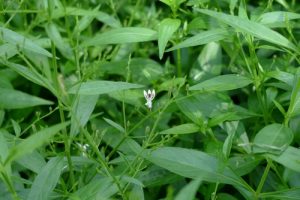A blog friend (thank you!!!) sent me the link to a few studies on andrographolide, extracted from a medicinal plant called Andrographis paniculate, native to South Asian countries and also known as the “king of bitters.” The leaves and underground stems of this plant are used for about a million purposes: to prevent and treat colds and the flu, to treat digestive disorders (diarrhea, colic, stomach pain and so on), liver conditions (jaundice, liver damage caused by medications), infections (all sorts, from pneumonia to rabies, even HIV/AIDS), and skin conditions.
The list is seemingly endless and even includes snake bites, loss of appetite, kidney problems, hemorrhoids, worms (ugh). It has antibacterial, anti-inflammatory, antiviral, anti-tumor, anti-fungal, and immune regulatory, properties. It also protects the gallbladder and the liver. Oh, and apparently it is good for the heart, too!
But the main reason I’m writing about this seemingly amazing substance today is because it has ANTI-MYELOMA properties. What I really like about this new (new to me!) substance is its “low toxicity and low cost.” 
Luckily for us, the main andrographolide-MM study, published in 2015, is available for free online, so you can read it, too. The whole shebang can be found here: goo.gl/Z9CaVF
Incidentally, this is the first study to discuss the effect of andrographolide on myeloma cells…
According to the abstract, these two Chinese researchers showed that andrographolide reduced the proliferation of MM cells and increased their death rate (apoptosis) by inhibiting the NF-kappaB pathway that we’ve learned so much about in all these years.
Results: as mentioned in the abstract: 1. andrographolide blocks the proliferation of myeloma cells; 2. It also KILLS them (“induces apoptosis”). And that’s really all we need to know, although the study offers other important details, too.
Let’s look at one of them, since it is connected to an item of MUCH interest that pops up later in the study: andrographolide reduces the levels of the TLR4 protein and of the NF-kappa B pathway in myeloma cells.
Discussion: andrographolide also inhibits angiogenesis, which is so important for the survival and wellbeing of myeloma cells, so that’s good to know, too.
Now we get to the above-mentioned importance of the TLR4 protein. TLR4 is apparently involved, not in a good way!!!, with a tumor’s microenvironment and has a lot of power over immune cells. So, if its activity can be blocked, that’s very good news. With andrographolide, this can be accomplished…
I mentioned TLR4 in one of my earliest posts, written in 2007: TLRs, or toll-like receptors, play a key role in the immune system. Back then, I was interested in the fact that TLR4 is inhibited by…yes…curcumin. This all makes sense, eh?
Anyway, definitely a very interesting substance. I’ll be looking at more studies on this topic in the next few days. I think it might deserve more than just ONE post. Right now it’s at the top of my list of stuff I intend to test…